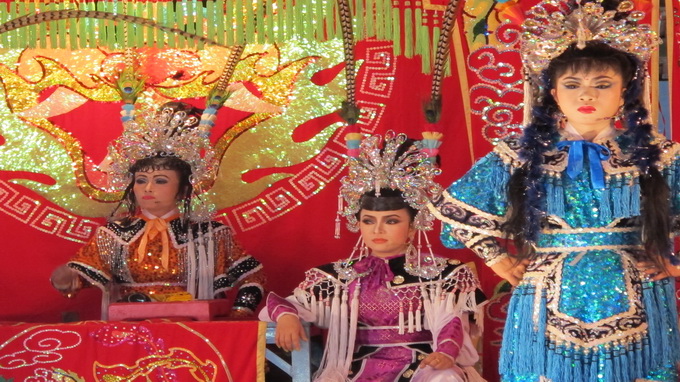More than a few artists have dedicated their whole lives to “hat boi”, also known as “tuong” (classical Vietnamese opera) though their art is struggling to survive due to intense competition from modern genres and is thus meagerly paid.
“Hat boi” saw its heyday in the 17th and 18th centuries and was considered the most thriving traditional genre in southern Vietnam.
My Tho town in Tien Giang province, the cradle of “hat boi”, was home to some dozen celebrated troupes, who performed regularly across the region. Their performances appealed greatly to people from all walks of life, from kings and royal families, court officials and the wealthy to average people.
However, the good old days are now long gone.
Behind the stage spotlight
Many years ago, Tien Giang did have theaters where “hat boi” troupes could perform, but they’ve been losing out to modern pop stages. “Hat boi” artists now can only cling to mobile troupes like Kim Loan to live out their lifelong passion and eke out a living.
70-year-old Bao An, who has performed the art for the past 54 years, is leading the artists from his Kim Loan troupe on a performing tour at temples in several southern provinces.
According to An, unlike “cai luong” (southern traditional music and performance) or drama, which is performed in 1-2 hour sessions, or pop songs which only take five minutes to perform, “hat boi” is typically staged in 4-6 hour performances due to the several acts needed in the enactment of each old tale.
“We always give the performances our best shot, if not, the audiences won’t give applause or tips, though the tips usually only amount to one or two US dollars for each artist by the end of a performance,” he shared.
The artists put on sparkling stage costumes for their roles as kings, generals, queens and princesses. However, at the end of the 6-hour play, the artists playing leading roles earn only VND350,000 (US$17) each, while those with supporting roles take home a mere VND200-250,000. Their pay is hurtfully meager compared to the thousands of US dollars which top-notch singers earn for a single song.
With such poor pay, most artists have to peddle wares before show time.
Seasoned artist Truc Phuong shared that while he was engrossed in his role as a general in front of an attentive audience, a young boy suddenly shouted out: “He isn’t a general. He peddles barley sugar in front of our temple.” The audiences burst out laughing at the boy’s naivety, while bitter tears rolled down the artist’s cheeks.
Against all odds, the artists remain dedicated to their art and believe that they are supposed to fulfill their lifelong mission assigned to them by the art ancestor.
Artist Linh Kieu and her husband took their 14-month-old child with them on the performing tour with the Kim Loan troupe.
“We’re working other jobs in Kien Giang province and dropped all our work as soon as we learned that the Kim Loan troupe would go on a performing tour. Transport fees and costume rental cost us VND4 million ($192) while there was no guarantee we’ll be paid even VND3 million for the entire tour. However, we can’t give up on the art, as it’s in our blood,” shared Kieu.
Unable to provide for his family with his meager incomes from “hat boi” performances, veteran artist Minh Vang has taken several menial jobs, including bike fixing on the sidewalk, to eke out a living.
“I was on the verge of giving up on my art job time and time again, but then I thought if my generation quits one after one, who will keep up the art for the next generations?”, he sadly said.
Other artists from Kim Loan troupe, most of who have followed the art for three or four generations, also perform at funerals, work as peddlers or dockers to wait for their brief moments to shine onstage.
““Hat boi” has indeed cast a spell on us all. When I was young, my father would teach me the art in bed by using his chest as the drum and we would stay up the whole night relishing in the art. His way of teaching and devotion left a lasting imprint on me,” recalled artist Bao An, whose parents are also reputable “hat boi” artists.
“Hat boi”, also known as “tuong”, is believed to be imported from China around the 13th century and was first performed in the royal court. Later on, the art was adapted and taken up by traveling troupes who entertained commoners and peasants.
The genre employs stock characters who are easily recognizable from their make-up and costumes, which are typically elaborate and rich in colors.






















































